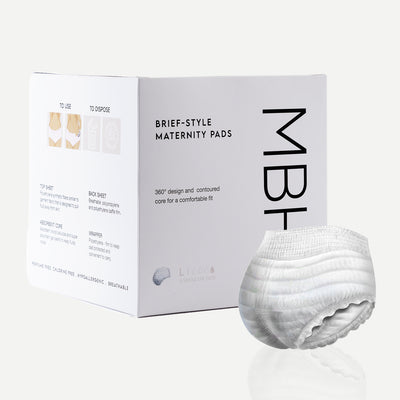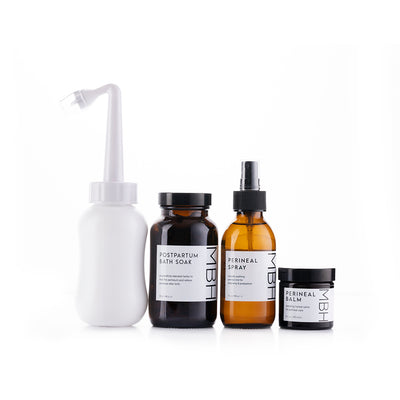Tips to Heal Your Perineum After Giving Birth
In addition to packing your hospital bag or preparing for a home birth, you will no doubt need to prepare a few things for your postpartum recovery.
Regardless of your birth experience, your postpartum recovery can be a tough time. If you give birth vaginally, your vagina, perineum and rectum are going to feel wounded, sore and in need of some serious TLC during your postpartum recovery. Even if you've had a cesarean you may still be pretty sore down there if you’ve done some pushing beforehand.
The severity of the aftermath will depend mostly on your birth experience. You might experience no tearing, just swelling and discomfort. Or, you might experience natural tears; these may be minor lacerations or you may need several stitches or require episiotomies.
Whether you experience minor discomfort, a natural tear or an episiotomy, there are several things that can offer relief and promote healing.
Here are some things you can do to help you heal after your birth:
DITCH THE TOILET PAPER
Regular toilet paper might be really uncomfortable to use on your swollen, stitched-up perineum. So for the first few weeks after childbirth, your peri bottle will be your best friend. Our Upside Down Peri Bottle is designed with an angled neck to make reaching the area a bit easier. The water comes out with gentle precision and gives you a continuous stream for efficient cleansing.
Using a peri bottle with warm water can help some women better empty the bladder by triggering them to relax and release. Use it every time you go to the bathroom to keep your wound clean and infection-free.
Witch Hazel is a great way to get some relief from perineal swelling and haemorrhoids and will be your best friend during your postpartum recovery. It’s an herbal skin soothing remedy with tannins and oils that can help reduce inflammation. Plus it has great wound healing properties which makes it an ideal remedy for soothing relief for vaginal swelling, painful or irritated stitches and any haemorrhoids that worsened or arrived with birth.
Here are our favourite ways to use Witch Hazel for your wound and stitches care:
A few generous sprays of witch hazel perineal spray directly on your perineum or on top of your pad can provide immediate relief from pain, itching, and swelling, while also promoting tissue healing.
Cotton pads that are soaked with a witch hazel solution can be layered on your maternity pads or folded and tucked into the folds of your bottom so they are directly in contact with the sore spot to relieve pain from haemorrhoids and postpartum swelling. Try these DIY soothing witch hazel pads.
TAKE A HEALING SOAK
Adding a herbal bath soak or epsom salt soak can feel like the ultimate relief once you’ve given birth. Not only is it soothing it can also encourage the healing process, increase your circulation, reduce swelling, cleans the area so there’s less risk of infection, and ease itching. Sitz baths are also a great remedy for painful, itchy haemorrhoids.
COLD THERAPY
Cold packs are a must-have for your postpartum self-care because cold therapy helps to soothe the pain and reduce swelling. Aside from the stitches, you’re going to have some pretty significant swelling in the vaginal area after childbirth. This is normal but also painful and uncomfortable. If you find that your labia is swollen, but not irritated, this can be normal and due to excess fluid. Ice will not help that swelling, but it can help swelling associated with tears and stitches.
You can use an ice pack or try making padsicles with witch hazel - these are frozen maternity pads filled with healing goodness that you put on your lady bits after birth. The herbal remedy plus the coolness offers double the soothing power.
DON’T BE SCARED TO POOP
Your first postpartum bowel movement will be daunting and some women find it extremely uncomfortable, while for others, it’s all about the anxiety, as you will be a bit constipated. This is because blood is diverted from your digestive system during labor and it will take a couple of days for you to get back to a normal rhythm. Pain medications can also contribute to constipation.
Stay well hydrated and eat foods naturally high in fibre to help get things going. If you need a little more help to get things going try taking some stool softener to help you get past the first few postpartum movements.
If you do get constipated do not strain, it might feel better if you hold a pad or clean tissue over the stitches when pooping. You can gently push up on your perineum as you bear down
Even if you are anxious, do not try to avoid using the bathroom when necessary. Holding it can make constipation and discomfort worse. For most, the anticipation is worse than actually going.
LET YOURSELF HEAL
Rest – easier said than done, but honestly, if you can lie in bed with baby whilst feeding or at any other opportunity as opposed to tackling chores, do it! Giving birth is a big task and one worthy of lots of rest to recover so listen to your body and rest.
Don’t pressure yourself to get back to your usual state in the early days and weeks just focus on feeding, bonding and resting. The more you rest, the more opportunity you give your body to heal. t’s also important to highlight that it’s not simply a process of physical recovery, but equally, a mental and emotional one so be kind and compassionate to yourself.




Leave a comment